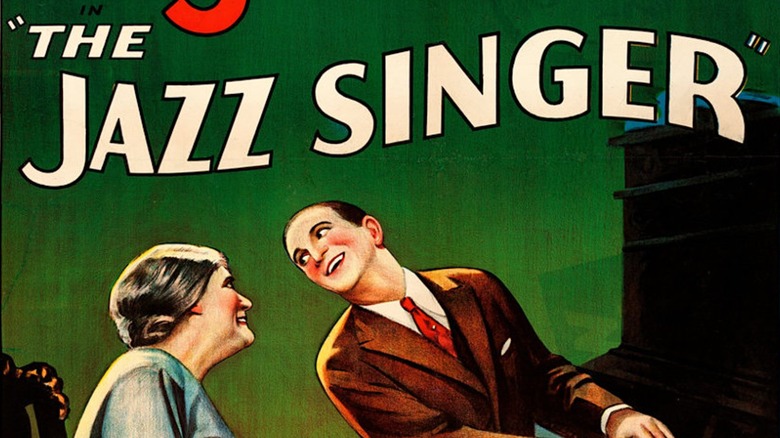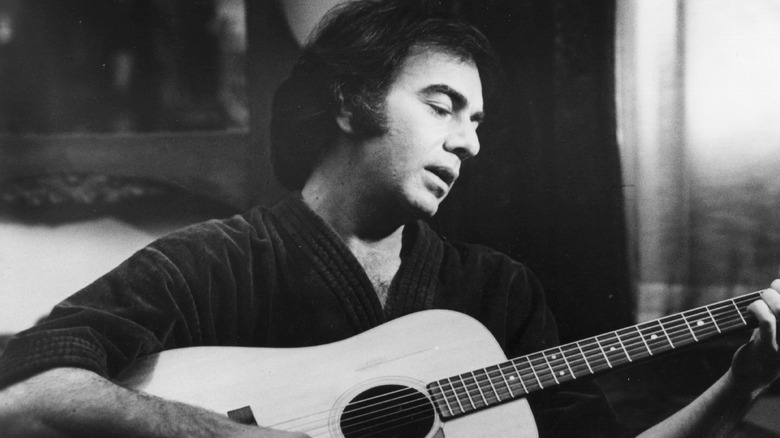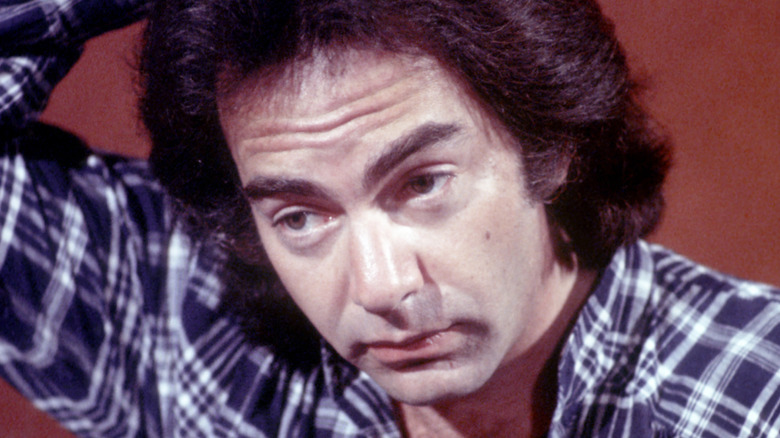This '70s Musician Completely Ruined The Jazz Singer Remake
The story of Neil Diamond as a professional musician began in the 1960s, and after a successful run as a songwriter, Diamond stepped into the spotlight. Between 1966 and 1974, he scored 15 Top 20 hits, including chart-topping classics like "Cracklin' Rosie" and "Song Sung Blue." His whole schtick as a mature, swaggering, thoughtful soft rock star then started to wear thin, only for Diamond to come roaring back in the late 1970s with "You Don't Bring Me Flowers" and "Desiree." Neil Diamond was cool again, and Hollywood came calling.
Convinced Diamond's theatricality, charisma, and appeal would translate to the big screen, movie producers built a film project around the musician: a remake of the 1927 saga "The Jazz Singer," which starred one of the era's biggest stars, vaudevillian and blackface performer Al Jolson, as a man torn between religious and familial obligation and his dream to be an entertainer. Here's the story of the disaster that was the Neil Diamond-starring 1980 version of "The Jazz Singer."
The Jazz Singer had to be changed to fit Neil Diamond
Hollywood loves to remake the same stories. Along with classics like "A Star Is Born" and "A Christmas Carol," "The Jazz Singer" has been repeatedly revisited. Originally released in 1927, the story was produced again in 1952, then as a made-for-television version in 1959, and once more — and the last to date — in 1980. The plot concerned a young man faced with his decided destiny: to be the latest in a long line of cantors, the singers who lead a congregation in musical prayer during Jewish religious services. Jacob Rabinowitz rejects that path and becomes a New York nightclub singer named Jack Robin, inviting disownment by his disappointed father, only to reunite just before the latter's death.
With the entertainment landscape changing drastically from 1927 to 1980, screenwriters Herbert Baker and Stephen H. Foreman updated the original story to suit Diamond and, they hoped, modern film audiences. No longer a nightclub or jazz singer, Diamond's character, Yussel Rabinovitch, aka Jess Robin, rejected the religious life to be a California-dwelling, arena-filling, swaggering soft rock star in the vein of Neil Diamond. Remarkably, and in a controversial moment Diamond would probably like forgotten, his character performs in blackface in one scene. That was a major element of the plot in the 1927 version of "The Jazz Singer" because it was a common practice at the time, particularly by star Al Jolson, but it was far less socially acceptable in 1980.
The Jazz Singer was a critical flop from which Neil Diamond barely recovered
"The Jazz Singer" wasn't a box office flop but wasn't a smash hit either, earning $27 million and ranking as the 17th-highest grossing film of 1980. The film critics of the day couldn't stand "The Jazz Singer," and Diamond's performance in particular. "'The Jazz Singer' has so many things wrong with it that a review threatens to become a list," wrote Roger Ebert. "This movie is about a man who is at least 20 years too old for such things to be happening to him. 'The Jazz Singer' looks ridiculous giving us Neil Diamond going through an adolescent crisis." Janet Maslin of The New York Times seemed to agree. "Diamond, looking glum and seldom making eye contact with anyone, isn't enough of a focus for the outmoded story," she opined.
At the very first Golden Raspberry Awards, or Razzies, bestowed on performers for terrible movie work, Neil Diamond won the inaugural Worst Actor award, defeating the likes of Sam J. Jones for "Flash Gordon," Caitlyn Jenner for "Can't Stop the Music," and Michael Beck for "Xanadu." "The Jazz Singer" was both the beginning and end of Diamond's side gig as a movie star. Apart from a few cameos as himself, Diamond never made another film.
Fortunately for Diamond, the music was well received. Some of Diamond's biggest hits and most remembered songs were Top 10 hits that originated on the soundtrack for "The Jazz Singer": "Love on the Rocks," "Hello," and "America."


